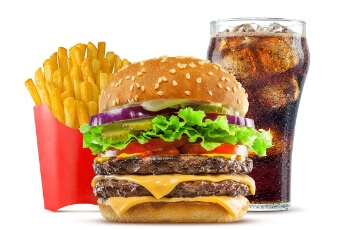Inflammation and your Health

It might seem tasty, but fast, highly processed food is a known cause of inflammation.
When you do think of when you hear “Inflammation”? Most people would say tangible, physical symptoms like pain, redness of the area affected, discomfort or swelling. But did you know Inflammation symptoms can also show up in the form of headaches, sinus issues, joint pain, digestive issues, muscle aches?
Inflammation is your body’s natural immune system response to an infection, injury or irritation. When you get a cut, you might have bleeding, pain, and swelling around that area. It’s the natural reaction by our body to protect us from bacteria and viruses. A fever (raised body temperature) is a NATURAL response by the immune system. It raises the body temperature in order to “kill off” the bad bacteria or virus!
Acute inflammation is necessary and a healthy, normal response! This is needed in order for our immune system to “react” and bring us back to homeostasis.
However, if the inflammation becomes chronic, lasts long term and is systemic (affecting the whole body) then that’s a problem. Think of if you have a cut that never goes away, or a fever that might lower but never breaks. Chronic inflammation is like having a low grade fever within your body all the time. Not good, and would have some negative consequences, right?
We think of Inflammation as only being external or physical symptoms. But many times, inflammation occurs within the body too, even though we can’t “see it”. In fact, Chronic Inflammation is at the root cause of ALL health conditions and diseases.
Internal, chronic inflammation can be caused by the same bacteria or viruses, but also a weakened immune system, all types of stress, nutrient poor foods, chemical exposure, lack of rest and sleep, etc. Many lifestyle factors play a role in the inflammation level within your body.
A big part of chronic, systemic inflammation is due to our diet. It may be the main factor in the increase of degenerative diseases. These are the most costly to treat and can take years to develop. These include diabetes, cancer, arthritis and Alzheimer’s.
How does it affect us? Certain ingredients, such as hydrogenated oils (trans fats) refined flours and sugars, antibiotics and hormones within conventional meat products, are all considered “foreign” to the body. It doesn’t see it as nourishing, whole foods…because they aren’t! So in response to this “invader”, it raises inflammation levels to get rid of it. Symptoms might include any type of digestive upset, headache or migraine, brain fog, fatigue, anxiety, joint or muscle pain. Additives such as artificial ingredients, fake sugars (like Splenda) vegetable oils, and genetically modified foods, like corn & wheat, are also triggers for inflammation.
Every time you eat a certain ingredient or get exposed to a certain chemical toxin, it is adding to that “low grade fever” happening internally. You might see the swelling or irritation on your skin, but that is what’s happening to your internal organs and tissues!
Does your diet consist mostly of foods cooked at high temperatures? Such as most “fast food?” Does your diet include a lot of refined sugar? Do you consume hydrogenated or refined oils? That would include potato chips, margarine and most baked goods. If so, you are more likely to be experiencing inflammation.
Instead, add more of these types of foods to your diet:
- Fruits, such as apples, berries, fresh pineapple, lemons, limes
- Vegetables, such as onions, tomatoes, greens (spinach, broccoli, kale), bell peppers, garlic
- Spices, such as cinnamon, ginger, basil, mint, parsley, rosemary
- Nuts and seeds, such as sunflower seeds, walnuts, almonds
- Fish, such as halibut, salmon, sardines, oysters
- Olive oil
- Beverages, such as green tea, black tea and good old eater!
Fortunately, we can control inflammation by being more mindful the foods we eat. Try to introduce at least one anti-inflammatory food into every meal. Many quickly notice relief from some of the symptoms that have been bothering them. Plus, as an added bonus, they’re better able to maintain a healthier weight.
Some other ways to Reduce Inflammation:
- Move Every Day. Daily Physical Activity is a nutrient our body needs to send blood flow, circulation and oxygen to all of our tissues. This is needed for any healing process to occur. A sedentary lifestyle (sitting more than you stand or move) raises inflammation. The more you move, the better your muscles and joints will feel, and then the better you will feel overall!
- Nourish your Gut. Over 70% of our immune system cells are actually located within your digestive tract. The microbiome has major responsibilities, including sending off that immune response to fight inflammation. But your gut also plays a role in detoxification and absorption of nutrients, both key parts to starting to feel better. Cutting out the inflammatory foods listed above will support a happy gut, but also avoiding OTC pain medications and antibiotics, which disrupt the good gut bacteria. Consider probiotic supplements and fiber rich foods (like veggies) which are needed to create a healthy microbiome and immune cells.
- Rest Up. Proper recovery and sleep is needed to fight inflammation. Sleep is when the body naturally detoxifies, repairs and recovers from any damage. Aim to get 7-8 hours of quality sleep per night. Schedule in down time and consistent days off from intense exercise as well.
Questions about how you can Reduce Inflammation, or confused on where to start?
Comment below or send us an email. we’d be happy to help!
